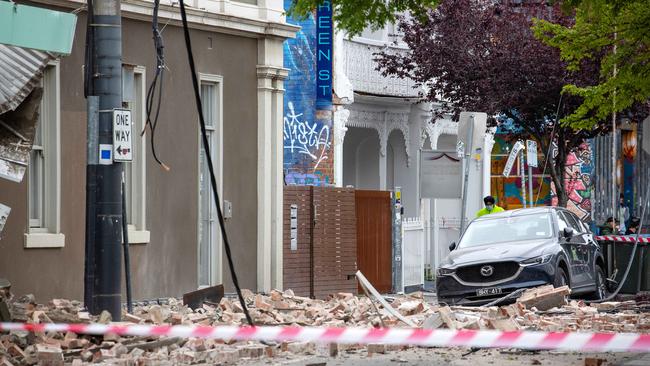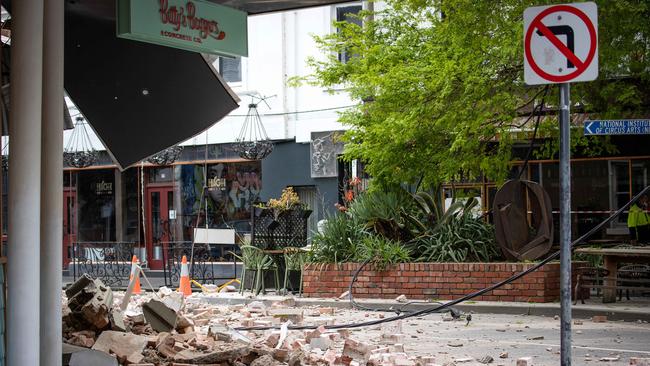Insurers brace for earthquake claims, but Australians urged to check wording
Insurers are preparing for a wave of claims following the eastern states earthquake, but not all building policies cover such natural disasters.

Earthquake claims are already rolling into insurers in the wake of tremors that rocked the nation’s capitals.
The magnitude 6 earthquake that shook the east coast on Wednesday morning resulted in several buildings being seriously damaged.
Insurers are now bracing for more claims in the wake of the quake as policyholders mobilise to assess damage.
The scale of the damage is still unclear, but Allianz noted 70 customers had made claims by mid-afternoon.
The Victorian Managed Insurance Authority, which covers most state assets including public hospitals, schools and infrastructure, said several clients had reported damage from the quake.
“VMIA is continuing to proactively contact clients with assets in impacted areas to offer support, and uses external assessors to conduct inspections as part of the claims process,” a spokeswoman said.
“VMIA insurance covers $3.625bn per event for damage sustained to property, with the first $50m retained by VMIA and the balance reinsured through a range of local and international reinsurers.”
The Insurance Council of Australia, the industry’s peak body, said it was monitoring the number of damage claims.
“We are working with the Victorian state government to ensure assistance is forthcoming for impacted property owners,” an ICA spokeswoman said.
“Under the Covid-19 restrictions insurers are permitted to conduct assessments and arrange emergency make safes and urgent repairs.”
Just wild. #VictorianEarthquakepic.twitter.com/irvXkaKxpY
— Matt Hickey (@mhickey23) September 21, 2021
The insurance industry is urging customers to check wording for coverage and act swiftly to ensure a swift response.
The majority of property insurance policies cover earthquakes, however many have varying wording for the time frame in which a claim can be made. Data from comparison site Canstar shows this claims window can vary from between two to seven days.
Many policies that do cover earthquakes charge an excess payment in the event of a claim.
Canstar group executive financial services Steve Mickenbecker said the timeframe was aimed at ensuring insurers were not stung by a long tail of claims after the event.
“Let’s say two weeks later you discover there is damage, how can you prove it’s from the earthquake?” he said.
He said damage from earthquakes could be hugely costly.
“There are certain events that when they occur cause massive and widespread damage,” Mr Mickenbecker said. “They’re not super frequent but when they happen they’re big events.”
The magnitude 5.8 earthquake that hit Newcastle in 1989 killed 13 people and injured 160.
Insurers were ultimately slugged for $3.2bn in losses resulting from the earthquake.
Natural disaster losses have slugged insurers with significant outlays in recent years.
Major insurers purchase cover for themselves with reinsurers to protect against losses arising from natural disasters.
An August report from risk consultancy Aon found natural catastrophes on average cost Australian insurers $1bn a year.
QBE, one of Australia’s largest insurers, locked in a $3.4bn ceiling to cover catastrophe claims arising from its global operations.

The insurer set aside $175m to cover non-peak catastrophe claims in Australia and New Zealand, up from $125m in 2020.
Shares in the listed insurers were shaken in the hours following the earthquake, with QBE falling 3.8 per cent before recovering to close 0.62 per cent down to $11.20. Suncorp fell 2.09 per cent to $12.17 and IAG closed 2.99 per cent lower at $4.87.
Velocity Trade senior banking and insurance analyst Brett Le Mesurier said it was unclear how costly the quake would prove for insurers given “there’s very little precedent”.
“Curiously the greatest risk insurers face is water in its many forms not earthquake risk, they leave that to New Zealand,” Mr Le Mesurier said. “How much it’s going to cost is really hard to say.”
A recent report by Munich RE, a reinsurance agency, found Australia was vulnerable to extreme and concentrated losses from an earthquake.
“The vulnerable, highly concentrated building stock has the potential for extreme losses,” the report said.
“A repetition of the 1954 Adelaide earthquake (magnitude 5.7) would result today in multi-billion insured losses. A bigger event closer to Adelaide could cause a loss costing tens of billion.”





To join the conversation, please log in. Don't have an account? Register
Join the conversation, you are commenting as Logout